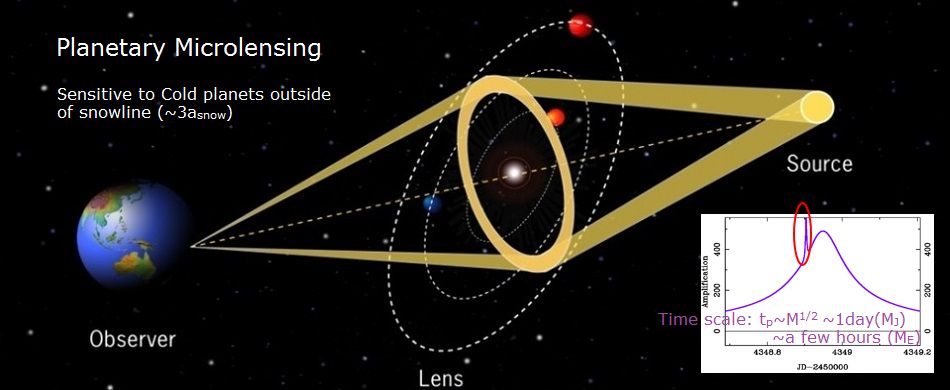

English | Japanese
|
1.Exoplanets There are eight planets in our solar system, including Earth. It is natural to wonder if other stars besides the sun might have planets as well. Such planets that exist outside the solar system are called exoplanets. Exoplanets are not easy to detect because planets are much fainter than stars. The claim of the discovery of exoplanets were already reported in the 19th century, but they were all later found to be false positives, and it was not until the 1990s that exoplanets were actually discovered. Observational techniques at the time were sensitive only to giant gas giants such as Jupiter, and many research groups were trying to capture signals from planets with long orbital periods of about 10 years, such as Jupiter in our solar system. However, the first exoplanet discovered in 1995 was a giant gas planet orbiting a sun-like star called 51 Pegasus with a very short period of about four days. The short period corresponds to the proximity of the orbit to the central star, which means that this giant gas planet is a scorching planet orbiting far more interiorly than Mercury in our solar system. For this major discovery that defied the conventional wisdom of the time, Dr. Michel Mayor and Dr. Didier Queloz of Switzerland were awarded the 2019 Nobel Prize in Physics. Since the great discovery in 1995, many research groups have been searching for short-period planets in the vicinity of central stars. As a result, new exoplanets have been discovered one after another, and as of 2019, more than 4,000 exoplanets have been reported. In particular, NASA's Kepler mission, which began its survey in 2009, has discovered more than 2,300 planets orbiting near the central star, and revealed that about 30% of solar-type stars have such planets in the vicinity of their main stars. On the other hand, the outer region of the solar system, corresponding to the orbits of Jupiter to Neptune, has not yet been fully explored. This region is called the "snow line," where it is thought that planet formation have occurred most actively, and it is very important to understand the planet formation process by elucidating the distribution of planets in this region. The gravitational microlensing method used in the PRIME project is the only method that is sensitive to Earth-mass planets in this outer orbital region, and by 2019, about 80 exoplanets, including planets orbiting in this outer orbital region, have been discovered using this method.However, this is only a few percent of the total number of planets discovered in the near-main star regions, and the statistics are still insufficient to measure the various distributions of planets.The PRIME project will construct the world's first near-infrared telescope for gravitational microlensing exoplanet exploration to increase the statistics of planets in the outer orbital regions by discovering many exoplanets, and to measure the distribution of various planets in the same region. 2.Exoplanet exploration by Gravitaional Microlensing The PRIME telescope observes exoplanets using a technique called gravitational microlensing, which makes use of the gravitational microlensing phenomenon. Gravitational microlensing is a phenomenon in which a stellar-mass object (lensing object) crosses between the Earth and a source star (source object), the gravitational field of the lensing object bends the light from the source object, acting like a lens, and the source object is observed as brightened light from the Earth (Figure 1).If the lensed object is a single lensed star, the light intensification curve will be very simple, but if the lensed object is a binary star system or a planetary system, the light intensification curve will show anomalies from the single lensing. Detailed analysis of the light intensification curves showing such anomalies can be used to detect binary and planetary systems. 
Figure 1:Schematic diagram of the gravitational microlensing. Light from the source object is bent by the gravitational field of the lensing object, and appears to be intensified to observers on Earth. Exoplanet searches using the microlensing method utilize light from the source object and are independent of the brightness of the lensed object, making it possible to detect planets around faint stars and floating planets. In addition, the way light is bent by gravitational lenses is independent of wavelength, whereas the way light is bent by glass lenses we use in our daily lives depends on the wavelength. Therefore, another feature of the microlensing method is that it can observe light at all wavelengths in the same way. Exoplanet exploration using the microlensing method has led to the discovery of several exoplanets every year. Figure 2 plots the masses of exoplanets discovered to date versus their distance from their host stars, with the red dots representing the exoplanets discovered to date by the microlensing method. The red dots represent exoplanets discovered by the microlensing method to date. The snow line is the distance from the main star at which water, ammonia, methane, etc. become cold enough to turn from gas to solid. It is believed that solid molecules increase rapidly beyond the snowline, which facilitates the growth of planetary cores, and planet formation becomes more active. Exoplanet exploration using the microlensing method, which has sensitivity to planets beyond the snowline, will greatly contribute to the elucidation of the planet formation process.
3.Observation of the Galactic center direction using near-infrared light The PRIME telescope uses near-infrared light to observe the Galactic center. Conventional visible light observations are unable to detect microlensing of source objects deep in the Galactic center (below 2 degrees longitude) due to the large interstellar attenuation caused by the interstellar medium between the Earth and the Galactic center. On the other hand, near-infrared observations are less affected by interstellar material and have lower attenuation, making it possible to observe regions that cannot be seen with visible light observations (Figure 3). In addition, since the galactic center is a region of high stellar density, more microlensing events can be observed, and the number of planets discovered is expected to increase by a factor of four compared to the current visible-light observations. The increase in the number of planets discovered will also increase the number of sub-Earth-mass planets detected, allowing for a more accurate estimate of planet distribution. Furthermore, by estimating the planet frequency in such regions of high star density and comparing it with the conventional visible light observation regions, we can verify the difference in planet frequency depending on the environment. PRIME is the first attempt of its kind in the world. 4.Synergy observation with Roman Around 2025, NASA's space telescope Roman (Nancy Grace Roman Space Telescope) is scheduled to be launched, which will perform microlensing in space, searching for exoplanets every 15 minutes for 24 hours over a 72-day period, covering about 2 Roman will perform microlensing searches of 100 million stars at approximately 2 square degrees in the center of the galaxy every 15 minutes for 72 days, 24 hours a day. Therefore, Roman not only has the advantage of much better precision than ground-based telescopes, it also has the advantage of not missing planetary signals of a few days to a few hours by observing continuously 24 hours a day, day and night. Optimization of Roman's microlensing region by PRIME's pre-launch observations is another of PRIME's scientific goals. The objective of PRIME is to construct a more efficient microlensing observation area. After the launch of Roman, the same microlensing phenomena will be observed simultaneously by both PRIME and Roman in cooperation with PRIME. This will allow us to detect "space parallax," the parallax effect of observing from two points, a ground-based telescope and a space telescope, and to put stronger limits on the physical quantities such as the mass and orbital radius of the planets to be discovered. |